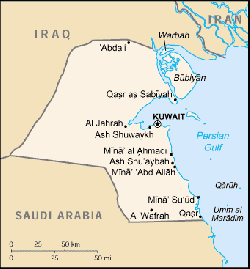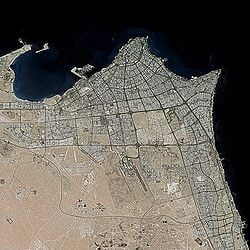Difference between revisions of "Kuwait City" - New World Encyclopedia
Mike Butler (talk | contribs) |
Mike Butler (talk | contribs) |
||
| Line 114: | Line 114: | ||
==Geography== | ==Geography== | ||
| + | [[Image:Kuwait City SPOT 1082.jpg|thumb|left|250px|Kuwait City seen from Spot Satellite.]] | ||
Etymology of name – if available. | Etymology of name – if available. | ||
Topography: Physical qualities of a particular place. Example: Mexico City | Topography: Physical qualities of a particular place. Example: Mexico City | ||
| Line 140: | Line 141: | ||
After Iraqi forces retreated from Kuwait in January-February 1991, foreign investors and the Kuwaiti government were actively involved in modernizing the city and turning it into a world-class business hub. Many hotels, shopping malls and offices were built in the city indicating the economic growth since the war. | After Iraqi forces retreated from Kuwait in January-February 1991, foreign investors and the Kuwaiti government were actively involved in modernizing the city and turning it into a world-class business hub. Many hotels, shopping malls and offices were built in the city indicating the economic growth since the war. | ||
| − | |||
[[Image:Kuwaittowers.jpg|right|thumb|250px|Built in [[1979]], the [[Kuwait Towers]] are the most famous landmark in Kuwait City.]] | [[Image:Kuwaittowers.jpg|right|thumb|250px|Built in [[1979]], the [[Kuwait Towers]] are the most famous landmark in Kuwait City.]] | ||
Revision as of 02:56, 9 January 2009
| Kuwait City مدينة الكويت Madinat Al Kuwayt |
|
| Kuwait City's skyline at night | |
| Coordinates: {{#invoke:Coordinates|coord}}{{#coordinates:29|22|11|N|47|58|42|E|region:KW_type:city | |
|---|---|
| name= }} | |
| Country | Kuwait |
| Governorate | Al Asimah |
| Area | |
| - Metro | 200 km² (77.2 sq mi) |
| Population (2005 estimate) | |
| - City | 32,500 |
| - Metro | 2,380,000 |
| Time zone | EAT (UTC+3) |
Kuwait City (Arabic: مدينة الكويت, transliteration: Madīnat al-Kūwait), is the capital and largest city of Kuwait. Located at the heart of the country on the shore of the Persian Gulf, and containing Kuwait's parliament (Majlis Al-Umma), most governmental offices, the headquarters of most Kuwaiti corporations and banks, it is the indisputable political, cultural and economic center of the emirate.
Geography
Etymology of name – if available. Topography: Physical qualities of a particular place. Example: Mexico City a. Mountain flanked basin b. on dry lake bed c. vulnerability to earthquakes d. trapped air pollution (also true in L.A. and Athens) Elevation Climate (not required unless it makes the city a resort) The city (Johannesburg) enjoys a dry, sunny climate, with the exception of occasional late afternoon downpours in the summer months of October to April. Temperatures are usually fairly mild due to the city's high altitude, with the average maximum daytime temperature in January of 79°F (26°C), dropping to an average maximum of around 61°F (16°C) in June. Winter is the sunniest time of the year, with cool days and cold nights. The temperature occasionally drops to below freezing at night, causing frost. Snow is rare. Mean annual precipitation is 28 inches (716mm). Rivers and canals Size – land area, size comparison Environmental issues Districts
History
Kuwait City was first settled in the early 18th Century by the Al-Sabāh clan, later the ruling family of Kuwait and a branch of the Al-Utūb tribe (that also included the Al-Khalīfah clan, the ruling family of Bahrain), and their leader, Sheikh Sabāh I. Its name may have derived from an earlier abandoned fort located there, called "Kūt" (كوت) - Arabic for a fortress by the sea.
The settlement grew quickly, and by the time its first wall was built (1760), the town had its own dhow fleet of about 800 and trading relations to Baghdad and Damascus. It was a successful and thriving sea port by the early 19th Century.
It was unclear whether or not Kuwait was part of the Ottoman Empire, and as a result, tensions often broke out between the sheikhdom and the empire. These tensions peaked when, in 1896, Sheikh Mubārak Al-Sabāh assassinated his brother, the emir Muhammad Al-Sabāh, over Mubārak's deep suspicion that the Ottoman Empire was willing to annex Kuwait.
In exchange for British naval protection, Mubārak was not to negotiate or give territory to any other foreign power without British consent. With the discovery of oil in 1936, the city’s standard of living improved dramatically, including health and education services.
In August 2, 1990, Iraqi forces seized the city and on August 8 they annexed the emirate. During the occupation, the city was extensively damaged and many buildings were destroyed after it, including the Kuwait National Museum.
After Iraqi forces retreated from Kuwait in January-February 1991, foreign investors and the Kuwaiti government were actively involved in modernizing the city and turning it into a world-class business hub. Many hotels, shopping malls and offices were built in the city indicating the economic growth since the war.
Suburbs
Although the districts below are not usually recognized as suburbs, the following is a list of a few areas surrounding Kuwait city:
|
|
Government
Kuwait is a constitutional hereditary emirate. The executive comprises the chief of state, who since January 2006 was Amir Sabah al-Ahmad al-Jabir al-Sabah, and Crown Prince Nawaf al-Ahmad al-Jabir al-Sabah. The prime minister is head of government. Since April 2007 Nasir Muhammad al-Ahmad al-Sabah has been prime minister. There are no elections; the emir is hereditary, and appoints the prime minister and his deputies. The prime minister appoints the Council of Ministers (cabinet) members of which are approved by the emir.
Economy
Kuwait is a small, rich, relatively open economy with self-reported crude oil reserves of about 104 billion barrels - 10 percent of world reserves. Petroleum accounts for nearly half of GDP, 95 percent of export revenues, and 80 percent of government income. High oil prices during 2007-2007 helped build Kuwait's budget and trade surpluses and foreign reserves. As a result, the need for economic reforms became less urgent and the government has not pushed through new initiatives. However, despite its vast oil reserves, Kuwait experienced power outages during the summer months in 2006 and 2007 because demand exceeded power generating capacity.
Per capita GDP was estimated at $55,900 in 2007.
Financial and business services sector Tourism Manufacturing
Kuwait City’s trade and transportation needs are served by Kuwait International Airport, Mina Al-Shuwaik (Shuwaik Port) and Mina al-Ahmadi (Ahmadi Port) 50 kilometers to the south, on the Persian Gulf coast.
Kuwait’s booming economy has allowed many international hotel chains to enter agreements to open hotels in the country. According to the Kuwait Hotel Owners Association, over twenty-five new hotels are planned or in construction, including the following:
- Golden Tulip Kuwait - opening late 2008
- The Regent Messilah Beach Resort & Spa - opening late 2008
- Hotel Missoni Kuwait - opening Q1 2009 (the world's first Hotel Missoni)
- Hilton Olympia Kuwait - opening Q2 2009
- The Monarch Luxury Hotel & Conference Center - opening late 2009
- InterContinental Kuwait Downtown - opening early 2010
- The Square Capital Tower - opening late 2010
- Four Seasons Hotel Kuwait at The Gate of Kuwait - opening 2011
By 2010, over 3,000 rooms are expected to be added to Kuwait’s hotel inventory.
Demographics
It has an estimated population of 63,600 (2006 estimate) [citation needed] within city limits and 2.38 million in the metropolitan area.
Race/ethnicity - historical background of ethnic groups Language Religion Colleges and universities
Of interest
Looking to the future
Does the city face no challenges or offer up anything else as a legacy?"
Does the city need reconstruction?
Is it a model city?
Will it run out of water?
Does it have a crucial role to play in the nation?
See also
- Madinat al-Hareer
External links
- World Fact Book 2009 Kuwait Retrieved January 9, 2009.
- (German) Kuwait City at "goruma"
Credits
New World Encyclopedia writers and editors rewrote and completed the Wikipedia article in accordance with New World Encyclopedia standards. This article abides by terms of the Creative Commons CC-by-sa 3.0 License (CC-by-sa), which may be used and disseminated with proper attribution. Credit is due under the terms of this license that can reference both the New World Encyclopedia contributors and the selfless volunteer contributors of the Wikimedia Foundation. To cite this article click here for a list of acceptable citing formats.The history of earlier contributions by wikipedians is accessible to researchers here:
The history of this article since it was imported to New World Encyclopedia:
Note: Some restrictions may apply to use of individual images which are separately licensed.

